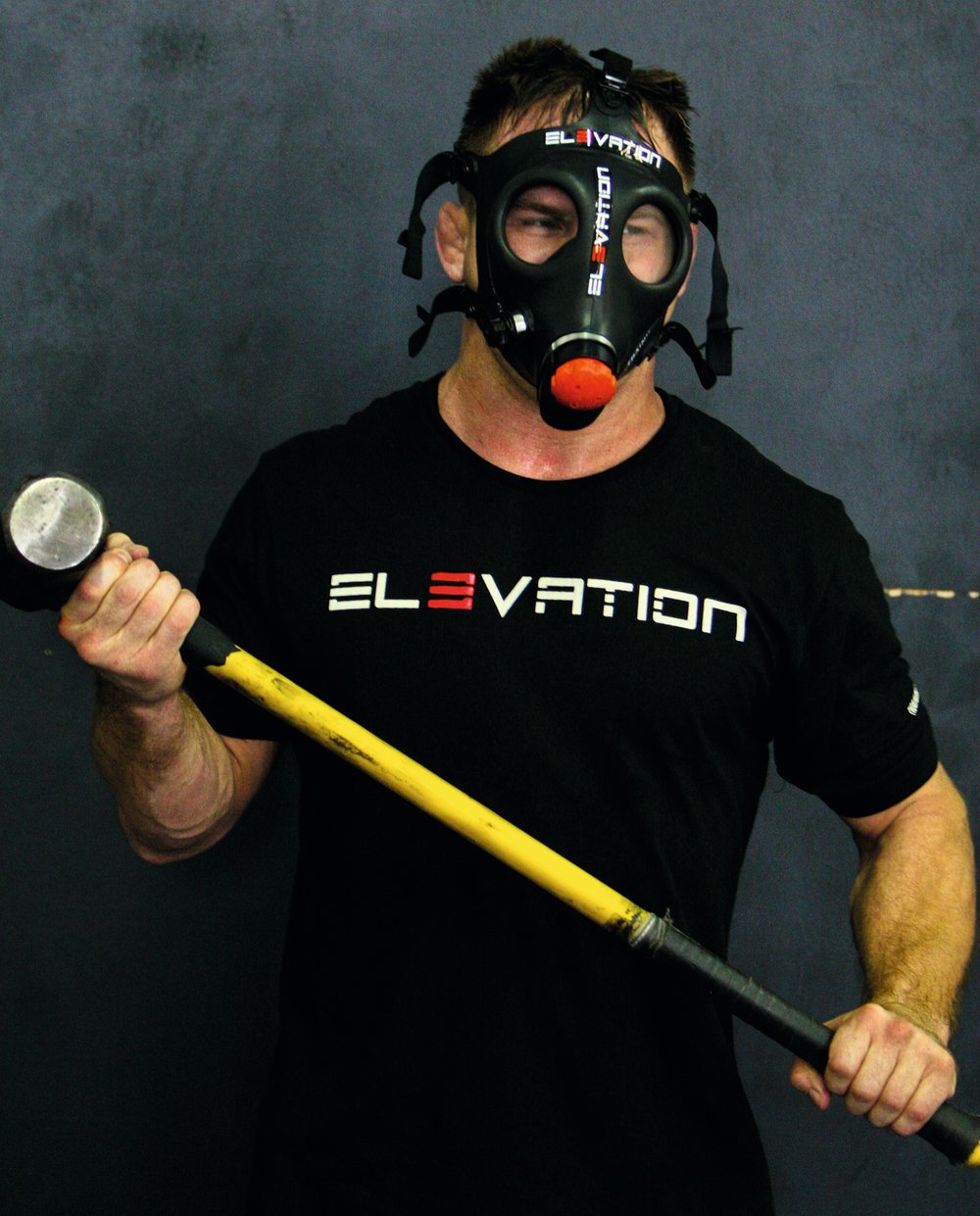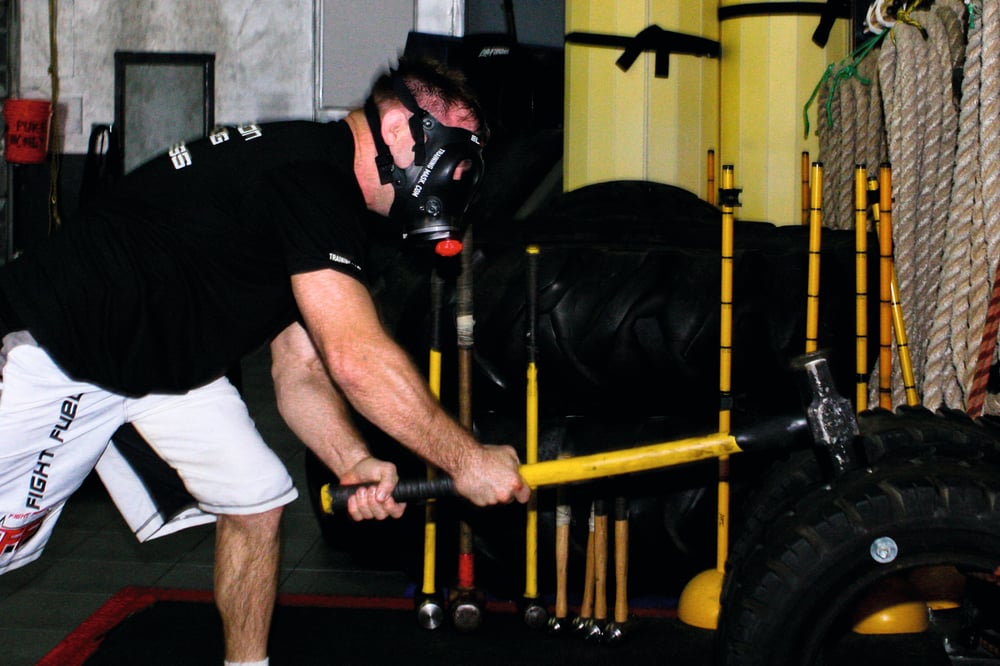
Issue 074
April 2011
Gassing out is a fighter’s fiercest enemy. Can ‘hypoxic’ training help? Feel the burn with the pros’ secret weapon for super-human cardio
Hypoxic training means working out in a low-oxygen environment to super-boost cardio. Getting less ‘O2’ means your body works harder, burns more calories and gives you more gas. It’s the same reason fighters like ‘Rampage’ Jackson and Tito Ortiz have held their fight camps in the thin air of mountainous climes for years. An emerging fitness trend at gyms for big-city elite, there's a simple option for health-inclined fight fans to get the same benefits without a Big Bear training trip.
You might have seen some fighters engaging in hypoxic training by taping a snorkel to their mouth, or even using special sleep chambers for that extra out-of-hours boost. But, as a simpler alternative there's always the Elevation Training Mask, an air-restricting full-face covering. Produced with the help of fitness-obsessed former UFC lightweight champion Sean Sherk, the mask is designed to closely mimic the low-oxygen environment of high-altitude training, and allows you to regulate the amount of air you can breathe in. If your body feels it’s not getting enough oxygen, it’ll produce extra red blood cells to get more of it around your system. Come fight night, your respiration will be jacked.
Sean explains the idea for the mask was born from an unlikely source. “For the last three years, we would go and get gas masks from a military surplus store,” says Sherk. “The gas masks were big and clumsy and we had to duct tape the holes and fix them up to get them to work the way we wanted them; but work they did.” It’s ironic that this jury-rigged tool was so effective considering a cutting-edge strength and conditioning center is right next door to Greg Nelson’s The Academy in Minnesota. API (Athletic Performance Inc) has no shortage of professional equipment alongside Sean’s preferred ‘caveman’ training tools. “We always kept it real quiet because I knew it was something that was working for me, something that I didn’t want to make public to the other fighters.” Inevitably, Sean wanted an improved, reliable version, so he worked with developers to create the Elevation Training Mask. “The product is now smaller, more manageable and, most importantly, it has the progressive airflow system which is the best part about it. That works much better than duct tape!”

How Does It Work?
The business end of the unit, which resembles a gas mask in appearance and design, is the removable nosepiece. This is the part that limits the airflow and you can either remove it entirely, or adjust it to one of three settings – with level three being the least restrictive and level one the most. According to Sean, the physical benefits of the mask are on the lungs and oxygen transportation system of your body. Red blood cells carry oxygen to your muscles. When there’s not enough oxygen – like at high altitude, or while wearing the mask – your body is forced to adapt to compensate, producing new red blood cells to improve oxygen transportation. When you return to normal oxygen levels – like at sea level, or if you remove the mask – your body has an increased VO2 max (ability to absorb oxygen). The training mask has the added benefit of strengthening your diaphragm and increasing lung capacity.
Mental Conditioning
The mask isn’t just about physical fitness. A big part of Sherk’s game is his apparent immunity to chokes, something he demonstrated in his last fight against Evan Dunham at UFC 119. In part, Sherk attributes that to his use of the Elevation Mask. “The mental side is a big part of getting used to the mask. You have to adjust to the fact that you’re fighting for air. I look at it like being choked. You’re fighting and you’re scrambling and you’re shooting and punching and you’re exhausted, then the next thing you know some guy’s wrapping his arms around your neck and you’re in a guillotine. Now your blood’s pumping and your adrenaline’s flowing but suddenly you can’t breathe any
more. You have to be able to relax and make the adjustments. Wearing the mask is a similar feeling. You’re working hard and doing your cardio and you’re not going to be able to breathe; you’ll be fighting for air the entire time. Just like in fighting you’ll have to find your ‘happy place’ and relax.”
While it’s tempting to get stuck in and supercharge your batteries, Sherk recommends using some caution initially. “Even if you’re a high-level athlete and think you can endure anything you should still do things properly and progressively,” advises Sean. “I’m a professional fighter and it’s what I do.
The UFC 155lb’er recommends using the mask regularly for best effects, emphasising that your body will adapt to the conditions the mask manufactures. “Do your cardio workout every day with the mask on: hit pads, drill takedowns, work the treadmill. Yesterday I was riding the Airdyne bike and jumping rope with my mask on. Four to five days a week, maybe half an hour a day – it depends on the individual and how much they can endure.”
Consistent use of the gadget is key, too. Working out with the mask regularly over a long period of time will help you see the gains. “You need three or four weeks. That’s backed up by studies and my personal experience. I start without the nosepiece too for the first week; there’s still some resistance. Then we’ll start moving it up. After a month I notice that when I train without the mask, my cardio is ten times better because I’ve acclimated my body to train with less oxygen. As soon as oxygen’s available, it’s just crazy; I can keep going and going and going without getting tired. I notice it after four weeks but scientifically, studies show that your body begins to change after three by creating more red blood cells which are what carries oxygen to your muscles.” It’s hard to argue with science.
More training tips at www.trainingmask.com

Sean’s Sample Elevation Mask Training Schedule
Week One:
“Take out the nosepiece, put on the mask, do a light, easy-paced cardio workout.
“Do this every day for a week to get comfortable with the mask.”
Week Two:
“Put in the nosepiece on level three and start to build the intensity of the workouts. As you progress, you may want to move up to level two then level one.”
From here you can increase the intensity, either being more anaerobically ambitious in training or working your way up through the nosepiece’s airflow levels.
Sean: “For my last fight I used the mask for eight weeks and I only used it up to a level two. We have level one because there are going to be those guys, extreme tri-athletes, ultra-marathoners or Olympic swimmers who can use it. It would benefit swimmers big time because it will really strengthen your lungs; when you’re breathing through those little holes you have to take longer, harder, deeper breaths.
“The first time you wear it you’re going to feel some strain on your lungs and your breathing muscles, so take it easy. Done like this, by the end of a training camp you’ll be able to do pretty much anything you like in the mask without being bothered. But, remember to stop using it a week before the fight. You need time for your lungs and breathing muscles
to rest.”
...









